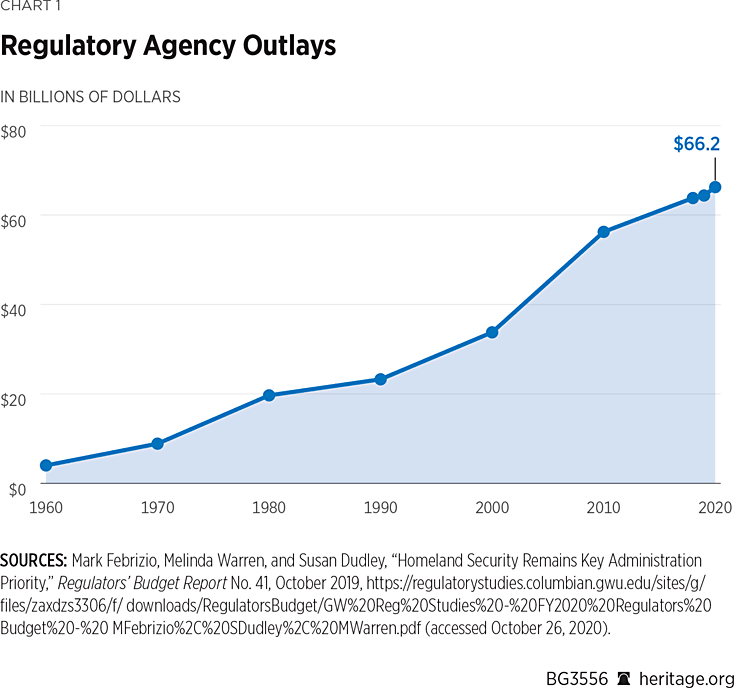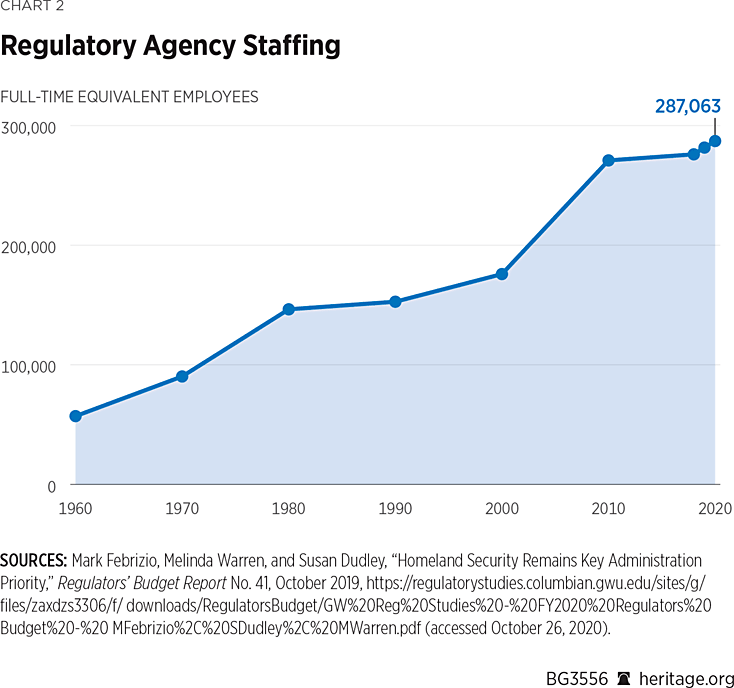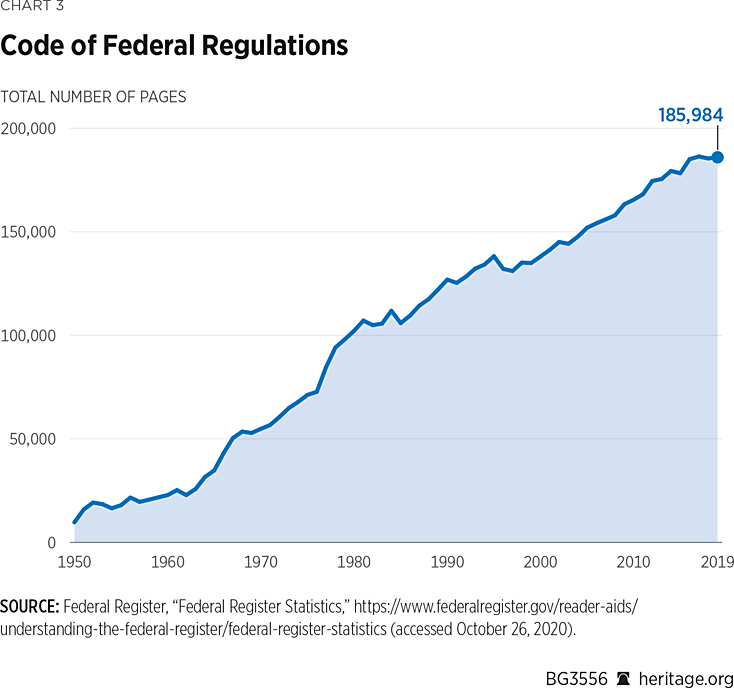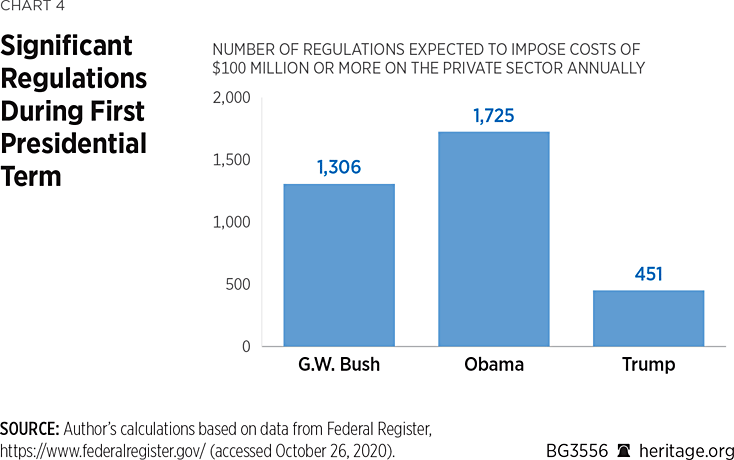The federal statute governing agency rulemaking and regulatory enforcement was enacted in 1946, and it has remained largely unchanged since then. Indeed, America’s regulatory apparatus is a relic of a bygone era, designed for economic, environmental, and political conditions that no longer exist. Systemic reforms are sorely needed, and—fortunately—opportunities exist to advance them in the coming year and beyond.
The outbreak of COVID-19 has raised public awareness about the importance of reducing regulatory barriers, including expanding access to telehealth services; speeding up the manufacture and distribution of masks, disinfectants, and other prophylactics; and accelerating vaccine development. This object lesson in deregulation should engender support for the reforms needed to better protect public health and revive the ailing economy.
The benefits of regulatory reform are numerous and well documented. The White House Council of Economic Advisers, for example, conservatively estimates that excessive regulation has stunted gross domestic product growth by 0.8 percent annually (on average) since 1980.REF An abundance of scholarship also documents a direct correlation between income and health.REF Simply put, squandering resources on regulatory overkill, strangling investment and innovation through unnecessary restraints, endangers livelihoods and lives.
Many of the nation’s foundational regulatory statutes were enacted a half-century ago, when municipal sewer systems emptied billions of gallons of raw sewage into rivers, the automotive fleet ran on leaded gas, and the rotary dial was considered high tech. The command-and-control framework upon which virtually all regulation was then erected reflected lawmakers’ relative naiveté about bureaucratic self-interest and the penchant of the regulatory state for power.
It is rather telling that none of the 454 agencies listed in the Federal Register tracks regulatory costs either cumulatively or in the aggregate.REF Some studies estimate that the annual cost of compliance for the private sector totals about $2 trillion, which equals the amount of individual and corporate taxes collected by the federal government.
Regulation acts as a stealth tax on all Americans and the entire U.S. economy: higher energy rates resulting from dubious global warming schemes; increased food prices from excessive production standards; restricted access to credit under reams of paternalistic dictates; and fewer health care choices and higher costs from a raft of medical mandates, to name a few.
While a burden for all, overregulation harms low-income families and fixed-income seniors the most; the costs translate to higher consumer prices that exhaust a relatively larger share of their household budgets. Moreover, the excessive spending on fashionable causes and hypothetical threats consumes resources that could be better spent remedying the actual environmental risks in low-income communities, such as contaminated drinking water and toxic soils.
The bigger the regulatory state has grown, the more essential political influence has become, leading to cronyism and corruption. Economic power and political power reinforce one another—just as they did when the Medicis ruled Florence and Tuscany in the 15th century.
This is not the limited government of America’s Founding, its constitutional framework, or its republican ideals. Regulation has become so pervasive that the fundamental character of the nation resembles servitude to the state more than individual liberty.
The Trump Administration, more than any of its immediate predecessors, has put significant effort into taming the regulatory stateREF—albeit challenged at every turn by “resistance” within the federal government and without. Regulatory proponents have challenged virtually every reform, often claiming that, absent aggressive federal intervention, public health and the environment are at risk. Litigation at every stage of the reform process not only impedes reform but also delays construction of safer and cleaner energy and transportation infrastructure. In actuality, the biggest improvements in both result from technological innovation, which is inhibited by excessive regulation.
The regulatory leviathan resists reform because it is a political spoils system by which bureaucrats impose their will and special interests profit. Regulatory agencies are command centers of resistance to reform, driven by self-interest as much as, or more than, they are driven by the public interest.
All three branches of government share the blame for excessive regulation, and action by all three is necessary to achieve meaningful reform. The President’s authority to modify regulation is limited; the White House cannot countermand regulatory directives from Congress. For its part, Congress evades accountability by crafting ambiguous statutory language that fills court dockets. The lawsuits enable judges to write law rather than interpret law.
It is not enough to simply reshuffle the rulemaking process. The nation must restore rulemaking to Congress, eradicate the cronyism that distorts policymaking, subject independent agencies to regulatory review, and strengthen standards of cost-benefit analyses—among other reforms. Unless constrained, the regulatory state will extinguish America’s entrepreneurial spirit and the freedoms on which this nation was founded.
Measuring the Regulatory Burden
The number and scope of federal regulations have grown without restraint for decades. Every facet of daily life, including how Americans heat their homes and light their rooms, which food they buy and how they cook it, the toys that occupy their children and the volume of their television commercials, are controlled by government. The paperwork burden alone now totals 11.6 billion hours annually at a cost to the private sector of $149.8 billion.REF
The total cost of compliance is unknown but includes direct expenses, such as the purchase of new industrial equipment, process and product re-engineering, retraining, record-keeping and administrative support, and lots and lots of legal advice. Indirect costs entail deferred investment in innovation, heightened barriers to competition, and diminished job creation.
As the number of regulations has grown, so, too, has spending on the federal bureaucracy. The President’s fiscal year (FY) 2020 budget requested $75.2 billion in outlays for regulatory activities, including 287,063 full-time employees.REF This budget request represents an increase of 96 percent compared to FY 2000 (adjusted for inflation) and a staffing increase of 63 percent.


The expansion of regulation since the 1960s, as evident in the volume of the Code of Federal Regulations, illustrates a disturbing shift in power from Congress to regulatory bureaucracies. As noted by Ohio State University Professor Christopher Walker, the 114th Congress passed 329 public laws totaling about 3,000 pages in the Statutes at Large. In the same two years, federal agencies promulgated more than 7,000 final rules comprising about 80,000 pages in the Federal Register.REF Congress is evidently content to pass vaguely worded aspirational legislation and to delegate the regulatory details to unelected bureaucrats who conduct the actual lawmaking.
That is a perversion of the constitutional principles of separation of powers, the rule of law, and due process.

The threat posed by regulatory excess goes well beyond rulemaking. More broadly, it represents what Alexis de Tocqueville termed “soft despotism,”REF that is, a society controlled by un-elected bureaucrats who somehow know what people’s best interests are better than they do. This Progressive paradigm demands that said bureaucrats wield all the powers otherwise constitutionally separated among the executive, legislative, and judicial branches as a check against tyranny. With decades of cooperation from activist judges and weak-willed Members of Congress, thousands of bureaucrats across dozens of federal agencies are doing exactly that.
The centralization of regulatory authority in Washington subverts direct accountability—taxpayers are unable to identify the officials responsible for regulatory policies, and the people making those regulatory decisions do not have to live with the consequences. This also imposes a staggering economic burden on the nation, but the greater cost is the loss of individual freedom and the flagrant breach of constitutional principles.
Recent Progress
The Trump Administration inherited 1,985 regulations in the rulemaking pipeline: 966 in the proposed stage and 1,019 in the final stage. In total, the Obama Administration issued more than 22,700 rules. The major rules imposing private-sector burdens increased annual regulatory costs by $122 billion, according to Heritage Foundation calculations.REF Combined with regulations imposed during the Administration of George W. Bush, the annual private-sector costs of red tape increased by more than $200 billion from 2001 through 2016.
Upon taking office, President Donald Trump launched a multifaceted reform agenda that targeted specific regulations as well as administrative reforms. Compared to rulemaking during the Obama and Bush Administrations, the volume of new regulations has slowed dramatically during the past four years. As of September 2020,REF the Trump Administration issued 73.9 fewer regulations than the Obama Administration (in the same period) and 65.5 percent fewer than the Bush Administration.

The Trump Administration has also withdrawn hundreds of proposed regulations from the rulemaking pipeline and repealed others—targeting the unwarranted green initiatives imposed under President Barack Obama. In conjunction with Congress, President Trump also applied the Congressional Review Act to block 16 last-minute Obama rules from taking effect. To date, a total of 43 rules have been repealedREF—a significant achievement given the complex, protracted, and litigious revocation process that can take years to conclude.REF
Some of the most significant repeals include:
- The Clean Power Plan (CPP). Executive Order 13783 directed the Environmental Protection Agency (EPA) to review and revise the $7.2 billion centerpiece of the Obama Administration’s global warming crusade. In June 2019, the Trump Administration repealed the CPP and replaced it with the Affordable Clean Energy rule—prompting a legal challenge. Also pursuant to the executive order, the Trump Administration revoked the 2015 greenhouse gas emissions regulations for new, modified, and reconstructed power plants. The proposed replacement regulations are expected to be finalized in 2020. President Trump also withdrew the United States from the Paris Climate Agreement on climate change in June 2017.REF
- “Waters of the United States” (WOTUS). The so-called WOTUS rule, revised in 2015 by the EPA and Army Corp of Engineers, vastly expanded the regulatory reach of federal regulators over water bodies and property across the nation. Legal challenges ensued, including half of all states as plaintiffs, and courts in a variety of jurisdictions ruled that the Obama Administration had exceeded its lawful authority. The Trump Administration rescinded the 2015 rule and promulgated a narrower regulation in January 2020.REF
- Corporate Average Fuel Economy(CAFE) standards. In 2012, the Obama Administration issued fuel-economy standards that would have required an industry fleet-wide average from 40.3 miles per gallon (mpg) to 41.0 mpg by model year 2021, and from 48.7 mpg to 49.8 mpg by model year 2025. In March 2020, the Trump Administration adjusted the standard to a more realistic 40.5 mpg by model year 2030 as part of its new Safer Affordable Fuel‐Efficient (SAFE) Vehicles rule. However, 23 states, five cities, industry, and nongovernmental organizations are challenging the SAFE rule.
- California CAFEwaiver. In September 2019, the EPA revoked California’s “waiver” from federal CAFÉ standards, which had authorized the state to set stricter CAFE standards. The National Highway Traffic Safety Administration also issued a final rule “preempting” states from regulating vehicle emissions of carbon dioxide or setting zero-emission vehicle requirements.
- Mercury and Air Toxics Standards (MATS) rule. In 2012, the Obama Administration imposed stringent controls on emissions of mercury and air toxics from fossil-fueled power plants. However, the Michigan Supreme Court invalidated the regulation, ruling that the EPA failed to properly determine whether the costly regulation was “appropriate and necessary.” In response, the agency attempted to justify the regulation by monetizing ancillary benefits of the rule (that is, a purported reduction in particulate matter). The Trump Administration, in April 2020, issued a “finding” that the analysis was improper because the benefits calculation should have been based on the pollutants targeted by the regulation. By that measure, the compliance costs “dwarf” the benefits and, therefore, the rule cannot be deemed “appropriate and necessary.”REF
President Trump has also issued at least 16 executive orders to reduce regulatory burdens. These directives help to reset agencies’ regulatory orientation. During his first month in office, for example, the President directed agencies to identify for elimination at least two prior regulations for every one new regulation issued, and to control regulatory costs through a budgeting process.
The regulatory budgeting is intended to inject a modicum of economic discipline into rulemaking. If agencies are compelled to restrict the costs imposed on the public, they must establish regulatory priorities and engage in a rolling review of the vast accumulation of rules.
Underway within the EPA is a major reform of how cost-benefit analyses are conducted for Clean Air Act regulations. The proposal includes a requirement that cost-benefit analyses use the “best available scientific information”9 in accordance with “best practices”10 from the economic, engineering, physical, and biological sciences. The agency is also proposing to increase transparency in the presentation of the cost-benefit results.
Other significant orders and memoranda include a much-needed modernization of the implementation rules for the National Environmental Policy Act.REF Once the vanguard of environmental law, the 1970 act and related regulations clash with current scientific tenets and economic realities. The revised rules will reduce barriers to infrastructure repair and construction and speed the nation’s recovery in the wake of the COVID-19 crisis—if not thwarted by enemies of reform and activist judges.
The Department of Justice, for its part, ended the Obama Administration’s practice of funneling billions of dollars in settlement funds to left-wing allies. The Federal Communications Commission (FCC) reversed the 2015 “net-neutrality” rule (formally titled the Open Internet Order), which subjected Internet service providers to regulations crafted decades ago for telephony.
In contrast to these and other valuable reforms, the Trump Administration has unwisely embraced a regulatory crackdown on social media, and ramped up government interference in infrastructure and trade. These inconsistencies detract from its deregulatory record.
Notwithstanding the multitude of reforms, victory cannot yet be declared. Executive orders can be summarily rescinded by a subsequent Administration, and the multitude of organizations and corporations that benefit from regulation are not about to relinquish their political advantages.
Ongoing Priorities
The challenge before the nation is to divest the regulatory state of its powers. This is no easy task given the decades of judicial deference and congressional delegation to agencies. Nor can the President alone accomplish the task. Congress and the judiciary must also pursue reform and refrain from further expanding regulators’ powers. All three branches of government share the blame for excessive regulation, and action by all three is necessary to achieve meaningful reform.
Reform need not be tangled in partisanship. The rapid growth of regulation should be a concern for all, and the reforms suggested here are measured responses to the problems at hand. The goal is not to arbitrarily reduce the number of rules. Instead, the goal is to ensure that each regulation is thoroughly assessed for necessity and effectiveness, and that policymakers are held accountable for the impacts.
Congress and the Administration should:
- Require congressional approval of new major regulations issued by agencies. Congress, not regulators, should make the laws and be accountable to the American people for the results. No major regulation should be allowed to take effect unless and until Congress explicitly approves it. In addition, legislators should include requirements for congressional approval of rules in every bill that expands or reauthorizes regulation.
- Set sunset dates for all major regulations. Rules should expire automatically if not explicitly reaffirmed by the relevant agency through the formal rulemaking process. As with any such regulatory decision, this reaffirmation would be subject to review by the courts.
- Codify regulatory impact-analysis requirements. All executive-branch agencies are currently required to conduct regulatory impact analyses (including cost-benefit calculations) when proposing new major rules. However, agency calculations of regulatory costs are notoriously inaccurate and imprecise. Codifying stringent methodological requirements would ensure that analytic standards cannot be rolled back without congressional action, and would provide the basis for judicial review of agency compliance.
- Subject independent agencies to executive branch regulatory review. Rulemaking is increasingly being conducted by independent agencies outside the direct control of the White House. Regulations issued by agencies such as the FCC, the Security and Exchange Commission, and the Consumer Financial Protection Bureau are not subject to review by the Office of Information and Regulatory Affairs (OIRA) or even required to undergo a cost-benefit analysis. This is a gaping loophole in the rulemaking process. These agencies should be fully subject to the same regulatory review requirements as those to which executive branch agencies are subject.
- Increase professional staff levels within OIRA. OIRA is one of the only government entities in Washington that is charged with limiting, rather than expanding, red tape. More resources should be focused on OIRA’s regulatory review function. This should be done at no additional cost to taxpayers: The necessary funding should come from cuts in the budgets of regulatory agencies.
- Require agencies to base rulemaking decisions on factual data, and to disclose any suchdata for public review. Federal agencies routinely mask politically driven regulations as scientifically based imperatives. The supposed science underlying these rules is often hidden from the public and unavailable for vetting by experts. Credible science and transparency are necessary elements of sound policy.
New Targets
The reform agenda of the past four years has largely focused on reversing the regulatory excesses of the Obama Administration as well as instituting administrative constraints on rulemaking. Regardless of the 2020 election outcome, unnecessary regulation will continue to plague the country and inhibit the nation’s economic recovery from the COVID-19 lockdown. It is essential to continue to repeal unnecessary regulations and to implement systemic changes. The following issues also represent opportunities for reform.
Few Statutes Delegate More Policymaking Power than the Clean Air Act (CAA). The CAA grants the EPA Administrator broad discretion to decide whether regulations are necessary and how stringent they should be. The agency also adjudicates regulatory compliance, which means that the EPA exercises legislative and judicial powers otherwise divided among the three branches of government as a check against tyranny.
A prime example of the agency’s sweeping powers is the setting of National Ambient Air Quality Standards (NAAQS). The CAA directs the EPA Administrator to identify and list particular air pollutants, and to issue air-quality criteria for those pollutants. In granting this rulemaking authority, Congress directed the agency to establish standards that are “requisite” to protect public health with an adequate margin of safety. The U.S. Supreme Court has upheld this delegation of authority as “well within the outer limits of our nondelegation precedents.”REF
The problems inherent in this broad delegation of authority are exacerbated by the open-ended nature of NAAQS rulemaking.REF That is, the CAA requires the EPA to review the adequacy of the NAAQS every five years, which is an invitation to impose ever-more stringent—and unattainable—standards that entail escalating levels of agency power.
The CAA is not the only case of regulatory ratcheting, but it does represent one of the most sweeping examples.
Federal Rulemaking Is Largely Conducted under the Administrative Procedure Act (APA) of 1946. The opportunity to submit comments is a crucial step in the process. Public notice also informs citizens about the substance of the rule and the supposed legal authority under which the agency is preparing the regulation.
A variety of research has revealed that a consistently high proportion of rules circumvent the notice and comment requirements by claiming a “good cause” exception under the APA. The exception allows the agency, “for good cause,” to declare that the notice and comment procedures are “impracticable, unnecessary, or contrary to the public interest.”
Agencies should not be authorized to decide unilaterally whether to undertake public notice and comment.
Technology Enables Citizens to Participate More than Ever Before in Federal Rulemaking. Online access to proposed rules and electronic filing of public comments facilitates citizen participation in rulemaking. However, there is increasing concern about whether special interests may be exploiting this technological access to sway rulemakings inappropriately. Public involvement is certainly a civic virtue, but what of robotic assistance? Do mass-comment campaigns substitute political pressure for policy substance? Do they increase the likelihood of fraud? As is generally the case, the government has been slow to respond to the technological changes in the rulemaking process.
Conclusion
The economic rebound from COVID-19 will depend, in part, on easing the regulatory burden on businesses that were forced to shut down by the outbreak. Small businesses, which employ half the workforce, have been hardest hit, and recovery is harder for them to achieve. Thus, the outbreak underscores the need for a lighter, more flexible regulatory approach.
The regulatory reforms achieved by the Trump Administration represent a major step in curtailing the further expansion of federal regulatory power. But much remains to be done. A change in Administration would likely shift the political dynamic, but it is to be hoped that the public and a significant proportion of Congress will remain predisposed to reform—particularly while the country is recovering from the pandemic and its effects. This agenda is intended to build on such support and open new windows for reform.
Diane Katz is Senior Research Fellow for Regulatory Policy in the Thomas A. Roe Institute for Economic Policy Studies, of the Institute for Economic Freedom, at The Heritage Foundation.
Appendix
The following are 16 executive orders (EO) issued by President Trump that reduce undue regulatory burdens and increase agency accountability:
- EO 13771, “Reducing Regulation and Controlling Regulatory Costs,” January 30, 2017.
- EO 13777, “Enforcing the Regulatory Reform Agenda,” February 24, 2017.
- EO 13778, “Restoring the Rule of Law, Federalism, and Economic Growth by Reviewing the ‘Waters of the United States’ Rule,” February 28, 2017.
- EO 13783, “Promoting Energy Independence and Economic Growth” (which also revoked EO 13653, “Preparing the U.S. for the Impact of Climate Change,” 2013, and numerous climate-related memoranda), March 28, 2017.
- EO 13792, “Review of Designations Under the Antiquities Act,” April 26, 2017.
- EO 13795, “Implementing an America First Offshore Energy Strategy,” April 28, 2017.
- EO 13807, “Establishing Discipline and Accountability in the Environmental Review and Permitting Process for Infrastructure Projects,” August 24, 2017.
- EO 13840, “Ocean Policy to Address the Economic, Social, and Environmental Interests of the United States,” June 19, 2018.
- EO 13867, “Issuance of Permits with Respect to Facilities and Land Transportation Crossings at the International Borders of the United States,” April 10, 2019.
- EO 13868, “Promoting Energy Infrastructure and Economic Growth,” April 10, 2019.
- EO 13875, “Evaluating and Improving the Utility of Federal Advisory Committees,” June 14, 2019.
- EO 13891, “Promoting the Rule of Law Through Improved Agency Guidance Documents,” October 9, 2019.
- EO 13892, “Promoting the Rule of Law Through Transparency and Fairness in Civil Administrative Enforcement and Adjudication,” October 9, 2019.
- EO 13921, “Promoting American Seafood Competitiveness and Economic Growth,” May 7, 2020.
- EO 13924, “Executive Order on Regulatory Relief to Support Economic Recovery,” May 19, 2020.
- EO 13927, “Accelerating the Nation’s Economic Recovery from the COVID-19 Emergency by Expediting Infrastructure Investments and Other Activities,” June 4, 2020.


